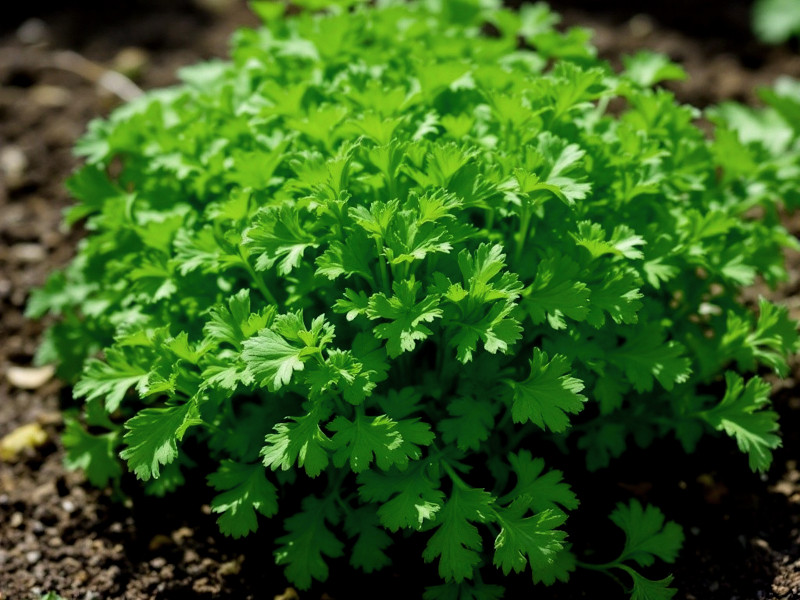Wise Mind Herbs
Evidence-based Herbal Healing
The information on this page has been prepared with reference to published scientific literature, not by a medically qualified expert. It is not medical advice. Any decision to use a supplement or herb-based product is your responsibility. Consult a suitably qualified medical professional, especially if you have underlying conditions. Remember, nothing is for everyone, and not everything sold is what it claims to be. Some things work for some people, some of the time.
Parsley - Petroselinum crispum
Parsley (Petroselinum crispum) is a widely used culinary herb belonging to the Apiaceae family. There are several varieties, with the most common being curly parsley (P. crispum var. crispum) and flat-leaf or Italian parsley (P. crispum var. neapolitanum). It should not be confused with Japanese parsley (Oenanthe javanica) or Chinese parsley (Coriandrum sativum, commonly known as cilantro or coriander), which are botanically distinct plants with different phytochemical profiles.

Bioactive Compounds
Parsley contains numerous bioactive compounds including flavonoids (apigenin, luteolin), essential oils (myristicin, apiol), coumarins, carotenoids, ascorbic acid, and various minerals. Apigenin and myristicin are among the most studied compounds for their potential therapeutic effects.
Evidence-Based Health Benefits
Scientific research has identified several potential health benefits of parsley, though it's important to note that many studies are preliminary, conducted in vitro or in animal models, with fewer high-quality human clinical trials.
- Antioxidant activity: Parsley exhibits strong free radical scavenging properties due to its flavonoid content, particularly apigenin and luteolin.
- Anti-inflammatory effects: Multiple studies demonstrate that parsley extracts may reduce inflammatory markers through inhibition of pro-inflammatory cytokines.
- Antimicrobial properties: Essential oils from parsley have shown activity against various bacterial and fungal strains in laboratory studies.
- Diuretic effects: Traditional use as a diuretic has some scientific support, with studies showing increased urinary output following administration of parsley extracts.
- Gastroprotective effects: Animal studies suggest protection against gastric ulcers and improvement in digestive function.
- Anti-diabetic potential: Some preclinical evidence indicates parsley may help regulate blood glucose levels and improve insulin sensitivity.
- Nephroprotective effects: Limited evidence suggests parsley may protect against kidney damage in certain experimental models.
Conditions with Some Evidence of Benefit
While parsley has not been definitively proven to "cure" any disease, scientific literature suggests potential benefits for:
- Urinary tract infections (due to diuretic and antimicrobial properties)
- Mild hypertension (through diuretic effects and vascular relaxation)
- Digestive disorders (through antispasmodic and carminative effects)
- Menstrual irregularities (limited evidence for emmenagogue effects)
- Inflammatory conditions (through anti-inflammatory mechanisms)
- Oxidative stress-related conditions (through antioxidant activity)
Recommended Dosages
Clinical standardization for parsley supplementation is limited, with inconsistent dosing protocols across studies. Based on available research:
- Dried leaf: 6-12g daily, divided into multiple doses
- Fluid extract (1:1): 4-8mL daily
- Tincture (1:5): 15-30mL daily
- Standardized extract (containing 1.0-1.5% flavonoids): 600-1200mg daily
- Essential oil: Not recommended for internal use due to safety concerns
Most clinical studies have used extracts standardized to flavonoid content (particularly apigenin) or essential oil components (myristicin, apiol) rather than whole herb preparations, making direct comparison difficult.
High-Dose Studies and Knowledge Gaps
Few studies have systematically investigated doses above the ranges mentioned. Limited toxicology research suggests that very high doses of concentrated extracts may exert adverse effects, particularly on kidney function and during pregnancy. Significant knowledge gaps exist regarding long-term safety, optimal dosing regimens, and standardization of preparations. More robust clinical trials are needed to establish efficacy thresholds, dose-response relationships, and safety margins.
Side Effects and Contraindications
While parsley is generally recognized as safe when consumed in culinary amounts, medicinal doses may cause:
- Photosensitivity reactions (due to furocoumarin content)
- Allergic reactions (particularly in individuals allergic to other Apiaceae plants)
- Kidney irritation (with excessive consumption)
- Hypotension (due to diuretic effects)
- Interactions with medications, particularly anticoagulants, diuretics, and lithium
Parsley is contraindicated during pregnancy (especially the seeds and essential oil) due to potential uterine stimulant effects. It should be used cautiously in individuals with kidney disorders, as high doses may irritate kidney tissues.
Synthetic homologues of parsley's bioactive compounds (particularly apigenin derivatives) are being investigated in preclinical research for various therapeutic applications, but no major branded pharmaceuticals based solely on parsley-derived compounds have achieved widespread clinical use.
References
Ahmed, W. E., Almutairi, A. A., Almujaydil, M. S., Algonaiman, R., Mousa, H. M., & Alhomaid, R. M. (2025). Nutraceutical potential of parsley (Petroselinum crispum Mill.): Comprehensive overview. Italian Journal of Food Science/Rivista Italiana di Scienza degli Alimenti, 37(1).
Bahramsoltani, R., Ahmadian, R., Daglia, M., & Rahimi, R. (2024). Petroselinum crispum (Mill.) Fuss (Parsley): an updated review of the traditional uses, phytochemistry, and pharmacology. Journal of Agricultural and Food Chemistry, 72(2), 956-972.
DeRango-Adem, E. F., & Blay, J. (2021). Does oral apigenin have real potential for a therapeutic effect in the context of human gastrointestinal and other cancers?. Frontiers in pharmacology, 12, 681477.
Mohamed, H. S. E., Hegazy, R. H., Bashir, M. H., Aboushady, I. M., Meselhy, M. R., El-Askary, H. I., & AbuBakr, N. (2025). Potential protective role of parsley on induced tongue carcinogenesis in albino rats. Dental and medical problems, 62(1), 79-87.
Nouioura, G., Kettani, T., Tourabi, M., Elousrouti, L. T., Al Kamaly, O., Alshawwa, S. Z., ... & Derwich, E. (2023). The protective potential of Petroselinum crispum (Mill.) Fuss. on paracetamol-induced hepatio-renal toxicity and antiproteinuric effect: A biochemical, hematological, and histopathological study. Medicina, 59(10), 1814.
Punoševac, M., Radović, J., Leković, A., & Kundaković-Vasović, T. (2021). A review of botanical characteristics, chemical composition, pharmacological activity and use of parsley. Archives of Pharmacy, 71(Notebook 3), 177-196.